 |
Climate vs. the Respiratory System |
1.00 |
This lesson briefly explores chronic respiratory illness. The benefit is we bring Meteorologist Bob Metcalfe to our discussion. You will quickly see that there are a number of things going on everyday that effect your respiratory patients that we should be aware of. Final Exam:Please read the questions carefully. You will have two attempts to obtain a 70% or higher. If you are not successful on your second attempt you are welcome to take the course again. Good luck! |
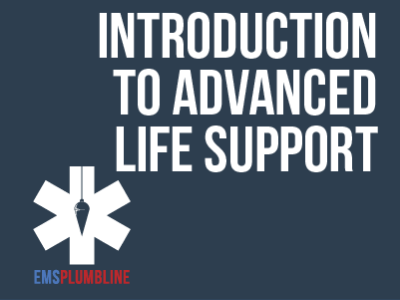 |
Constructing: Airway Essentials—Part 4 |
1.00 |
This lesson explores a few BLS concepts that every ALS provider should know. You will appreciate the back-to-basics approach Dr. Christopher Galton, uses to ensure adequate ventilation. Final Exam:This multiple choice exam is designed to test your knowledge of the material you just reviewed. You have two attempts to gain an 80% or higher on this exam. Please take your time and answer each question carefully. |
 |
Structural Search Operations (NYS12) |
1.00 |
This lesson familiarizes the firefighter with structure fire search and rescue operations. The lesson reviews primary search methods including Orientated, TIC Led and Vent Enter Search. Methods for conducting structural search as well as managing occupants and victims are introduced. These methods are based on operational risk assessment with firefighter safety as the prime focus. The lesson is evaluated with in-lesson activities and a final multiple choice quiz. |
 |
Fire Behavior Basics (NYS02) |
1.00 |
This lesson introduces the basic chemistry and physics of fire behavior. The lesson defines combustion, reviews the fire triangle and components of the fire tetrahedron. The stages of fire develop and accompanying characteristics are discussed with a focus on heat transfer and how it plays a part in fire develop. The lesson is evaluated using a brief quiz covering the material included in the lesson. |
 |
Constructing: Airway Essentials—Part 6 |
0.50 |
This lesson on how to instrument the airway will give you fantastic ideas on how to create your next lab session. Take note as some pearls are offered by Dr. Christopher Galton, on how to assess and manage ALS airway procedures. Final Exam: This multiple choice exam is designed to test your knowledge of the material you just reviewed. You have two attempts to gain an 80% or higher on this exam. Please take your time and answer each question carefully. |
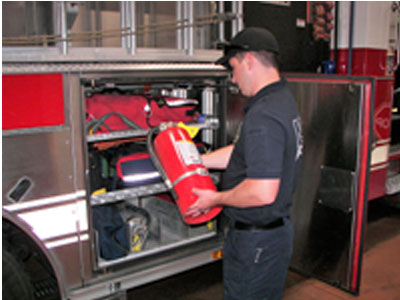 |
Fire Extinguishers (NYS03) |
1.00 |
This lesson reviews the identification, selection, and use of different types of fire extinguishers. The lesson begins with a review of the basic science of fire. The classifications are defined and described and the extinguishers that meet those classifications are identified. Fire extinguisher maintenance is described and reviewed. Finally, the PASS method of fire extinguisher operation is defined and described. |
 |
Dance for Joy: Movement, Music, and Rhyme |
1.00 |
This module from Dance for Joy will provide teachers with resources and activities that can be used and modified to support physical, mental, social, and emotional development in young children.
This course covers 5 activities: I Touch My Nose, I Touch My Toes, Hold Yourself Tight, Wake Up Right, Reach One Way, Reach the Other, Locomotor Freeze Dance, Salt and Pepper Dance. |
 , ,  |
Dance for Joy: Confident, Calm, and Compassionate |
1.00 |
This module from Dance for Joy will provide teachers with resources and activities that can be used and modified to support physical, mental, social, and emotional development in young children.
This course covers 5 activities: Tickle the Sky, Tapping, Every Little Cell, We are One, Scoop up the Universe. |
 |
Connection Planning in Long-Term Care |
1.00 |
This module includes training for staff and providers in the importance of social connection and practical strategies learners can use to promote social connectedness in long-term care. The module explains how to implement Connection Planning, a brief, person-centered behavioral intervention for developing resident care plans that address social connection. Connection Planning includes evidence-informed, practical strategies to promote meaningful social connection among residents in long-term care. |
 |
Ketorolac in Prehospital Medicine |
0.65 |
This module is designed to introduce Ketorolac (Toradol) to providers in the MLREMS region as an optional addition to the formulary. |
 |
Supporting Self-Awareness and Self-Management for Paraprofessionals |
0.75 |
This online course is designed to empower paraprofessionals with the knowledge and practical strategies needed to effectively support self-awareness and self-management in students. Participants will explore the importance of self-awareness and self-management, learn about key concepts, and gain actionable techniques to create a positive and inclusive learning environment that fosters emotional well-being and ethical growth in students. |
 |
Supporting Social-Emotional Learning and Character Development for Paraprofessionals |
1.00 |
This online course is designed to empower paraprofessionals with the knowledge and practical strategies needed to effectively support social-emotional learning (SEL) and character development with their students. Participants will explore the importance of SEL and character development, learn about key concepts, and gain actionable techniques to support a positive and inclusive learning environment that fosters emotional well-being and ethical growth in students. |
 |
Engaging English Learner Families and Communities |
2.00 |
This online course serves as a compliment to Healthy Cultural Identities and Engaging Families and Communities, an in-person training offered through CalSAC's English Learner Training and Professional Development Project. This course will help participants go deeper and gain more examples and strategies related to some of the 5 Tips for Engaging English Learners' Families and Communities introduced in the training. |
 |
Transitioning Three Raptors to an Operant Conditioning Program |
1.00 |
This presentation will address how the application of Operant Conditioning techniques were applied to training 3 free lofted raptors for Education programs in our Wildlife Education Division (WLE) at the San Diego Zoo Safari Park. Raptors previously utilized for the WLE division have been traditionally handled and crated for travel without the use of operant conditioning and positive reinforcement. We will demonstrate the benefits of pro-active behavioral management through the application of food and weight management techniques and the use of positive reinforcement from the trainers. Additionally we will discuss how a reinforcing environment without the rehearsal of avoidance behavior or aggression leads to future success and positive relationships. |
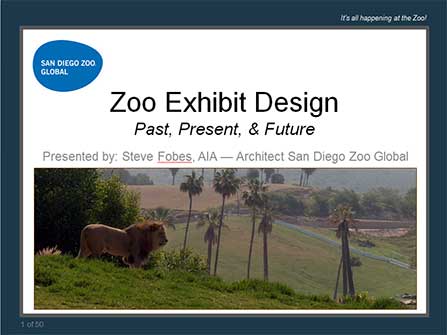 |
Zoo Exhibit Design: Past, Present and Future |
1.00 |
This presentation will give a brief history of zoos and animal exhibit design, discuss the theories behind modern exhibitry and the process for implementing them, and will end with a look at where exhibit design is headed in the future. |
 |
Animal Show Development |
1.00 |
This program will provide information about how best to present animals to your guests. We will discuss different types of programs including informal animal encounters, a free flight bird show, a cheetah run program and a mixed species show, including sea lions. For each type of program, we will discuss staffing, collection planning and production, such as sound and props. We will also talk about scripting in general and especially responsible messaging. |
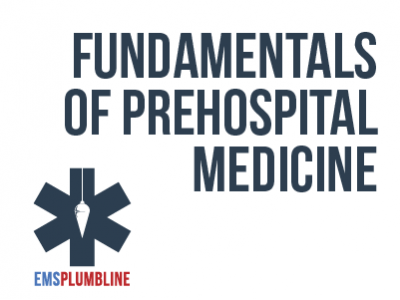 |
Building Upward: Resuscitation of Anaphylactic Shock Part 4—Scenario 3 |
1.00 |
This scenario involves a patient with special needs who has developed angioedema. Paramedic student Vanessa Petote and Medical Director Dr. Jeremy Cushman speak about the care that a special needs patient must receive, as well as the specific challenges that accompany a patient with a potentially unstable airway. Final Exam: Please read each question carefully. You will have two attempts to gain a 70% or higher on this exam. If you are not successful in two attempts, you are welcome to take the course again to gain the certification. |
 |
Mammals |
4.50 |
This series of five modules provides you with a greater understanding of the wide range of the types of mammals and some of their remarkable adaptations, enabling you to be a better interpreter, animal care professional, volunteer, or simply a better informed individual. Information includes an overview of physical characteristics, habitat, behavior, reproduction, and the conservation efforts dedicated to protecting this taxonomic group. Individual modules allow for a more focused approach to the material, as each takes a narrow scope. Each module includes self-assessment opportunities and its own mastery test. |
 |
Art and Sensory Experiences that Foster Creativity (CDA 2) |
2.00 |
This session equips you with the knowledge and tools to differentiate art projects from crafts in your early childhood setting. Learn how to cultivate the "doing" over the "having," crafting captivating experiences that engage multiple senses. Discover expert strategies for sparking imagination, nurturing creativity, and providing your young learners with endless opportunities for artistic expression. |
 |
Creating a World Famous Culture in your Workplace |
1.00 |
This session will give you an overview of how the World Famous San Diego Zoo defines company culture, and what forward thinking innovations they undertook to transform their culture into a World Famous Culture. You will learn a "zooprint" for success on company culture, including several best practices that you can use in your own workplace. |
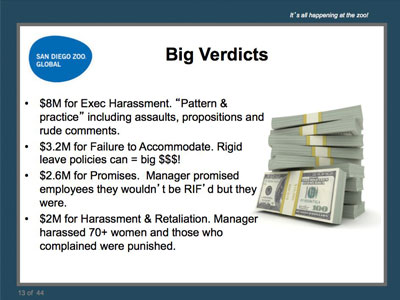 |
Labor Law Round Up |
1.00 |
This session will give you the latest employment law developments and answers to tough employment law questions, presented in a high energy, interactive session. You don't want to miss this one... |
 |
Customer Service: Listening and Questioning |
0.75 |
This topic will discuss the various types of listening: passive, selective, and active. You will learn that paraphrasing or summarizing what the customer says is a good way to confirm what you hear. In this course, you will also learn about questioning and the types of questions that are used to elicit the information you want from customers. There are four types of questions: open-ended, closed, alternative-choice, and clarifying. This course will also discuss the examination process that can be used to understand the customer’s problem and prescribe a realistic solution. |
 |
PPE Care and Maintenance #1931 (Instructor Guide) |
1.00 |
This training session is a PowerPoint presentation and skill demonstration. The presentation is an instructor lead discussion that reviews the importance of proper use and care of personal protective equipment for structural firefighting. The lesson reviews NFPA standards for structural firefighting PPE; 1971 and 1851. The lesson discusses the importance of proper care of the gear including selection, inspection, and storage. The procedure for inspection and cleaning of the PPE is reviewed including washing, drying, and repairing. The inspection procedure is demonstrated by the instructor and performed by the student. The student is able to describe how to conduct routine maintenance and care of PPE by the end of the lesson. |
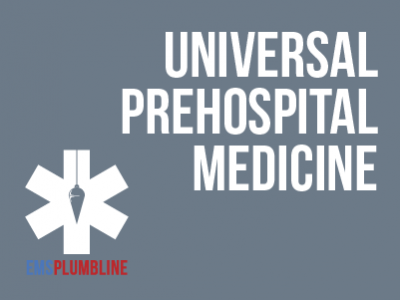 |
Communicating with the Deaf Sign Language User |
1.00 |
This training was developed by Dr. Jason Rotoli, Deaf Health Pathways Director, University of Rochester School of Medicine and Dentistry in conjunction with Dr. Jeremy Cushman, Chief of the University of Rochester’s Division of Prehospital Medicine. Funding for the Care of the Culturally Deaf education was provided by Society of Academic Emergency Medicine. Continuing Education provided by EMSPlumbline
Final Exam: This multiple-choice exam is designed to test your knowledge of the material you just reviewed. You have three attempts to gain an 80% or higher on this exam. Please take your time and answer each question carefully. |
 |
OSTPD - Supporting Alternative Pathways through Service Learning |
1.00 |
This training will cover a number of areas regarding how after school programs can support alternative pathways by using service learning. The course will review what service learning is and provide a solid foundation of this concept. It will then look at the benefits of service learning followed by how service learning supports youth’s alternative pathways. It will conclude with information on how to get started and creating a path to implement service learning in your own program.
|







 ,
, 


















